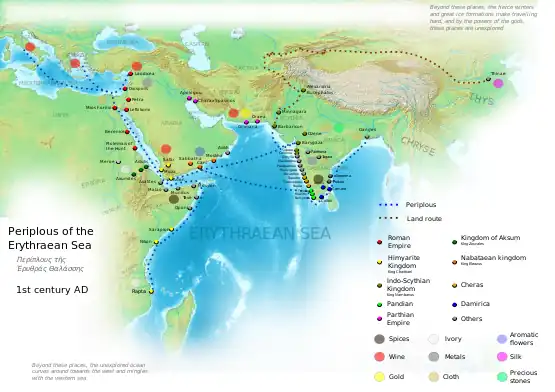| Ancient Opone | |
 | |
| Location | Hafun, Somalia |
| City-state existed: | 1st millennium BC–500 AD |
Opone (Ancient Greek: Οπώνη) was an ancient proto-Somali city situated in the Horn of Africa Hafun, Somalia. It is primarily known for its trade with the Ancient Egyptians, Romans, Greeks, Persians, and the states of ancient India. Through archaeological remains, the historic port has been identified with the city of Hafun on the Hafun peninsula in modern-day Northeast Somalia.[2] It is possible that it corresponds to the Land of Punt as known by the ancient Egyptians during the Old, Middle, and New Kingdom.[3][4][5]
History and trade
Pottery found in Oponean tombs date back to the Mycenaean Kingdom of Greece that flourished between the 16th and 11th century BC.[6] Its major periods of activity were during the 1st century BC and the 3rd to the 5th centuries AD.[7] Opone was mentioned by an anonymous Greek merchant in the 1st century AD Periplus of the Erythraean Sea. The town is featured in the ancient document's thirteenth entry, which in part states:
And then, after sailing four hundred stadia along a promontory, toward which place the current also draws you, there is another market-town called Opone, into which the same things are imported as those already mentioned, and in it, the greatest quantity of cinnamon is produced, (the arebo and moto), and a great quantity of tortoiseshell, better than that found elsewhere.
Opone served as a port of call for merchants from Phoenicia, Egypt, Greece, Persia, Yemen, Nabataea, Azania, the Roman Empire and elsewhere,[8] as it sat at a strategic location along the coastal route from the Mochan trading center of Azania to the Red Sea. Merchants from as far afield as Indonesia and Malaysia passed through the city, exchanging spices, silks, and other goods, before departing south for Azania or north to Yemen or Egypt on the trade routes that spanned the length of the Indian Ocean's rim. As early as 50 AD, it was well known as a center for the cinnamon trade, along with the barter of cloves and other spices, ivory, exotic animal skins and incense.
Archaeological remains
Ancient Egyptian, Roman and Persian Gulf pottery has been recovered from the site by an archaeological team from the University of Michigan. In the 1970s, Neville Chittick, a British archaeologist, initiated the British-Somali expedition where he and his Somali colleagues encountered remains of ancient drystone walls, houses with courtyards, and the location of the old harbour.
See also
References
- ↑ Periplus of Erythraean Sea
- ↑ The Indian Ocean in antiquity By Julian Reade pg 449
- ↑ "Punt". Ancient History Encyclopedia. Retrieved 2017-11-27.
- ↑ Flückiger, Friedrich August; Hanbury, Daniel (2014-03-20). Pharmacographia. Cambridge University Press. p. 136. ISBN 9781108069304.
- ↑ Wood, Michael (2005). In Search of Myths & Heroes: Exploring Four Epic Legends of the World. University of California Press. p. 155. ISBN 9780520247246.
opone punt.
- ↑ An Archaeological Reconnaissance of the Horn: The British-Somali Expedition 1975, Neville Chittick pg 133
- ↑ Shaw, Ian; Robert Jameson (2002). A Dictionary of Archaeology. Wiley. p. 264. ISBN 978-0-631-23583-5. Retrieved 25 September 2010.
- ↑ "Steam Workshop::Gedemo Opone City-State". steamcommunity.com. Retrieved 2020-05-25.